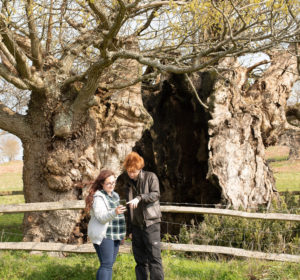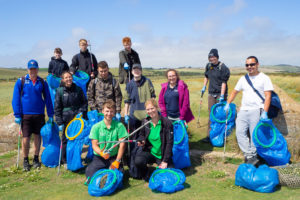Outcome 8: Creating Custodians
More responsibility and action is taken by visitors, communities and businesses to conserve and enhance the special qualities and use resources more wisely.
- WHY IS IT IMPORTANT?
One of the key challenges for the National Park is to increase the opportunities to enjoy it without creating unsustainable pressure upon it.
Encouraging widespread knowledge and understanding, and creating a greater sense of place, allows residents, businesses and visitors to build a stronger connection to the landscape and encourages more people to make a positive
contribution.One of the best ways to do this is through volunteering.
There are currently 3440 volunteers undertaking activities relevant to National Park Purposes, delivering huge benefits and creating a powerful network of ambassadors.
This includes the South Downs Volunteer Ranger Service (SDVRS) and
volunteers working for many other conservation and heritage organisations.The large number of people living in and around the National Park provide a
great opportunity to further expand and diversify these activities, and we are working to remove the barriers some groups face to accessing them.
For this outcome our priorities for the next five years are:
- 8.1 INCREASE VOLUNTEERING
To increase and diversify volunteering opportunities that support the National Park.
Over 170 organisations provide volunteering opportunities relating to National
Park purposes. Volunteers contribute 95,120 days each year, a staggering £5,136,480 cash equivalent (using living wage calculations).Volunteers therefore provide a great practical resource, make a huge impact as ambassadors and, at the same time, improve their own physical and mental wellbeing.
However, at present, the volunteering profile in the South Downs is not representative of the regional demography. In particular, young people (age 16−25), people with disabilities, people from more socially disadvantaged
communities and people from BAME communities are under-represented and this is something we intend to address.There are a number of factors affecting the current demographic of volunteers, including the nature of the tasks offered. Of organisations supporting volunteering, 98 per cent of those recently surveyed cited practical tasks/
conservation as the main roles offered.Important as this is, it is also important to offer a wider range of volunteer activities which respond to people’s evolving needs and interests.
Example: Youth Ambassador Volunteers
 The Authority has created a new volunteer role specifically for young people, that of Youth Ambassador.
The Authority has created a new volunteer role specifically for young people, that of Youth Ambassador.Two young conservation volunteers from within the SDVRS were recruited to this role and have been busy engaging with more young people.
To date, the Youth Ambassadors have represented the National Park at Careers Fairs and public events, and have initiated an Instagram take-over to promote micro-volunteering opportunities.
They have spoken to the wider National Park Volunteer Network and inspired other organisations to consider adopting this model of youth empowerment.
Example: South Downs Youth Action
 The landscapes of the South Downs will always need volunteers to support and improve biodiversity.
The landscapes of the South Downs will always need volunteers to support and improve biodiversity.South Downs Youth Action is aimed at young people aged 16−25 who get the chance to volunteer through taking part in specific activities and micro-volunteering during the summer months.
The aim of the approach is to increase the percentage of young people who volunteer from 4.5%, giving them an opportunity to help support this nationally-important landscape and to improve their own health and wellbeing.
